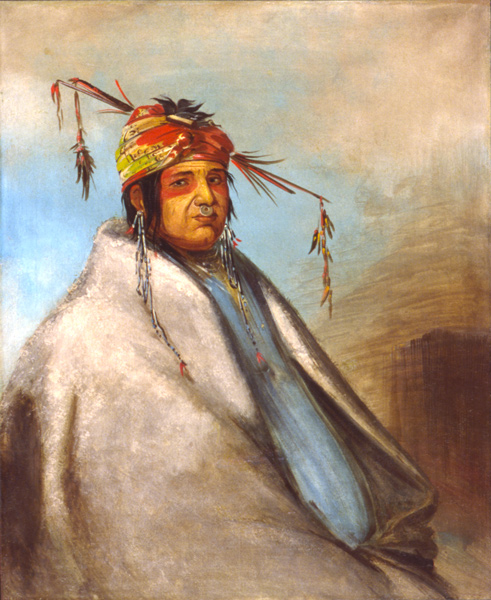Non-on-dá-gon, a Chief
George Catlin (1796–1872)
Smithsonian American Art Museum, Gift of Mrs. Joseph Harrison, Jr. Permission via Create Commons. No rights reserved.
Non-on-dá-gon was a lower chief of a Delaware phratry—a clan-based social division.[1]Ives Goddard, Handbook of North American Indians: Northeast Vol. 15, ed. Bruce G. Trigger (Washington, D.C.: Smithsonian Institution, 1978), 230 About him, the artist wrote the following:
Non-on-dá-gon, with a silver ring in his nose, is another of the chiefs of distinction, whose history I admired very much, and whom, from his very gentlemanly attentions to me, I became much attached to. [Both his and Ni-co-man’s] dresses were principally of stuffs of civilized manufacture; and their heads were bound with vari-coloured handkerchiefs or shawls, which were tastefully put on like a Turkish turban.[2]George Catlin, Letters and Notes on the Manners, Customs, and Condition of the North American Indians, reprint (Edinburgh: John Grant, 1926) 2:117.
The French called them the Loups (wolf). The captains spelled their name Delewar, Delaway, Deleeaway, and Dillewar—variants of today’s Delaware. That name came from a time they resided on the river named after Thomas West, Lord de la Warr, the first governor of Virginia. Due to confusion, at one time they called themselves the Lenni Lenape—Lenni, ‘the real’; Len, ‘real’; and ape, ‘person’. The redundant Lenni was eventually dropped. The Plains Sign Language for the people mimics the ribbons on a woman’s hair ornament.[3]Moulton, Journals, 3:446; Goddard, 236.
The Algonquian-speaking Lenape Delaware were the people who in 1626 accepted 60 guilders—valued at over $1000 in today’s dollars—of gifts from Peter Minuit, the Dutch governor of the New Netherland Colony. The Lenape thought the gifts were given in appreciation of their willingness to share “Manahatta” island—Lenape for “the island of many hills.” The colonists thought they had consummated a legal and binding purchase of the island now known as Manhattan.[4]Goddard, 220; Joshua Feinberg, New York City Department of Education, a PowerPoint field trip guide to Inwood Hill Park, accessed on 8 December 2020, … Continue reading
After European contact, the Lenape Delaware migrated heavily, typically mingling with other tribes. They resided in Ohio, Indiana, Illinois, Missouri, Wisconsin, Arkansas, Texas, Mexico, Kansas, and then the Indian Territory [Oklahoma].
About 1784, a small group of twenty Shawnees and Delawares migrated from Illinois to southeastern Missouri. Ten years later, the Spanish encouraged members in Illinois to migrate to the Apple Creek area north and west of Cape Girardeau as a way to proetct their settlements from the Osage and also to “strengthen the west bank of the Mississippi from the Americans.”[5]Louis Houck, A History of Missouri from the Earliest Explorations and Settlements Until the Admission of the State into the Union (Chicago: R. R. Donnelley & Sons Company, 1908). After the 1795 Treaty of Greenville, the majority of the people lived along the White river in Indiana.[6]Goddard, 223.
In 1803, the Americans Lewis and Clark encountered several Shawnee and Delaware communities west of the Mississippi between the Ohio River and St. Louis. On 12 March 1804, after the official transfer of Upper Louisiana to the United States and at the request Meriwether Lewis, the former governor of Upper Louisiana, Carlos Dehault Delassus, gave a speech addressed to the Delaware and other nations informing them that their “old fathers, the Spaniards and the Frenchmen,” join them in grasping the hand of their “new father, the head chief of the United States.”[7]Walter B. Stevens, St. Louis: The Fourth City, 1764–1911 (St. Louis: S. J. Clarke Publishing Co., 1911), 288. For more of the speech, see on this site 12 March 1804. Given the people’s long history of avoiding the Americans, the invitation was likely poorly received.
In “Estimate of the Eastern Indians,” Clark writes that 800 Delaware resided “on a Small Creak near Cape Girardeau.” Besides this large Apple Creek settlement, they reported 60 souls living with the Kickapoos at the mouth of the Missouri, 80 people living with the Miami along the Des Moines River, and a community of Cherokee, Creek, Lenape Delaware, and Chickasaw near New Madrid.[8]Moulton, Journals, 3:446.
Today, the Lenape people belong to the Delaware Nation and Delaware Tribe of Indians in Oklahoma; and the Stockbridge-Munsee Community in Wisconsin. In Ontario, they are the Munsee-Delaware Nation, Moravian of the Thames First Nation, and Delaware of Six Nations.[9]“Lenape,” Wikipedia, accessed 11 December 2020, https://en.wikipedia.org/wiki/Lenape.
Selected Encounters
March 12, 1804
Informing the Indians
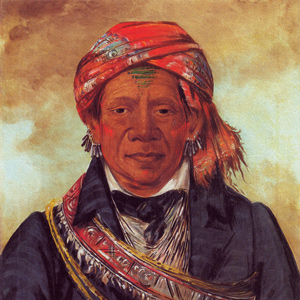

Winter Camp at Wood River, IL At the request of Capt. Stoddard and in the presence of Meriwether Lewis, Dehault Delassus delivers a speech to Indians informing them of the transfer of Upper Louisiana to the United States.
November 16, 1803
Seaman not for sale
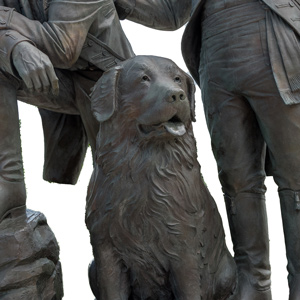

Mouth of the Ohio, IL The captains scout the western shore of the Mississippi where a Shawnee Indian tries to buy Lewis’s dog, Seaman. In Washington City, Thomas Jefferson defines the boundaries of Louisiana and plans more expeditions.
November 23, 1803
Louis Lorimier of Cape Girardeau
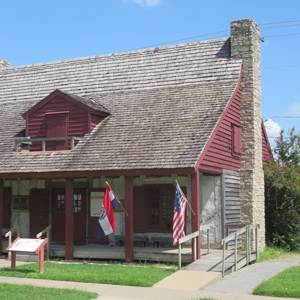

Old Cape Girardeau, MO Lewis brings letters of introduction to Louis Lorimier, whose store was burned to the ground by George Rogers Clark in 1782. Pryor still hasn’t returned from a hunting trip, and Clark’s illness continues.
March 27, 1804
Making corn meal
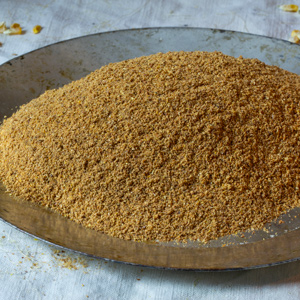

At winter camp across from the mouth of the Missouri, the men make corn meal from parched corn. Clark reports he is sick and notes the appearance of buds on the spice bushes.
September 15, 1803
Passing Belpre
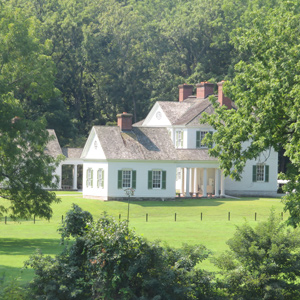

Blennerhassett Island, WV On a rainy day, Lewis heads down the Ohio passing the present-day Little Kanawha and Little Hocking rivers. The big boat must be lifted over a bar of gravel. They are further delayed when one of small boats falls behind.
December 23, 1803
Uncertainties with Louisiana slaves
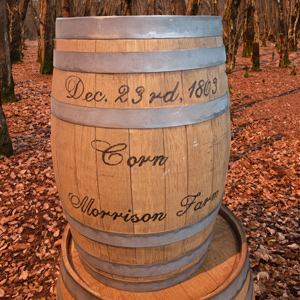

Winter Camp, Wood River, Illinois
Lewis investigates potential problems with the current French system of slavery and the future transfer of Louisiana to the United States. At Wood River, work continues building huts and a Lenape Delaware Indian known to Clark visits.
Notes
| ↑1 | Ives Goddard, Handbook of North American Indians: Northeast Vol. 15, ed. Bruce G. Trigger (Washington, D.C.: Smithsonian Institution, 1978), 230 |
|---|---|
| ↑2 | George Catlin, Letters and Notes on the Manners, Customs, and Condition of the North American Indians, reprint (Edinburgh: John Grant, 1926) 2:117. |
| ↑3 | Moulton, Journals, 3:446; Goddard, 236. |
| ↑4 | Goddard, 220; Joshua Feinberg, New York City Department of Education, a PowerPoint field trip guide to Inwood Hill Park, accessed on 8 December 2020, https://www.grownyc.org/files/rcp/slideshow_inwood.pdf; estimate of value by The International Institute for Social History, Amsterdam in “Manhatten,” Wikipedia, accessed on 11 December 2020, https://en.wikipedia.org/wiki/Manhattan#cite_note-60. |
| ↑5 | Louis Houck, A History of Missouri from the Earliest Explorations and Settlements Until the Admission of the State into the Union (Chicago: R. R. Donnelley & Sons Company, 1908). |
| ↑6 | Goddard, 223. |
| ↑7 | Walter B. Stevens, St. Louis: The Fourth City, 1764–1911 (St. Louis: S. J. Clarke Publishing Co., 1911), 288. For more of the speech, see on this site 12 March 1804. |
| ↑8 | Moulton, Journals, 3:446. |
| ↑9 | “Lenape,” Wikipedia, accessed 11 December 2020, https://en.wikipedia.org/wiki/Lenape. |
